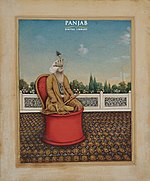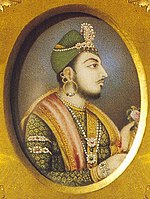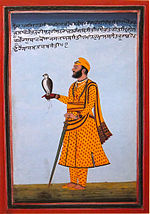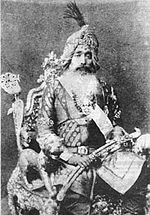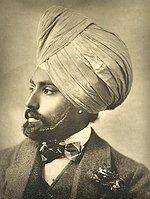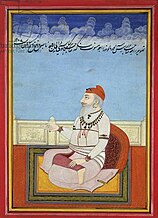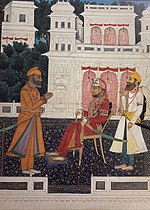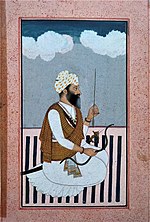List of monarchs of Punjab
Maharaja of Punjab
Style First monarch Udayana 6th century – 5th century BC (first known ruler) Last monarch Duleep Singh 1843–1849 (as Maharaja of Punjab )Formation 11th century BC Abolition 29 March 1849 Residence Appointer Hereditary Pretender(s) none
This article lists the monarchs of Punjab from the ancient kingdom of Sindhu-Sauvīra around 1000 BC until the deposition of the Sikh Empire in 1849.[ 1]
Udayana or Udrayana or Rudrayana (6th to 5th century BC)
Kesikumara (5th century BC)
The Achaemenid Empire at its greatest extent
Pauravas
Porus (before 326 BC, probably 338 BC – between 321 and 315 BC)
The Macedonian Empire at its greatest extent
The Maurya Empire at its greatest extent
map of Indo-Greeks and their expansion into India
Northern Satraps
Northern Satraps in early 1st century
Ruler
Image
Title
Approx. dates
Mentions
Hagamasha Satrap
1st century BCE
In the archaeological excavations of Sonkh , near Mathura , the earliest coins of the Kshatrapa levels were those of Hagamasha.[ 6]
Hagana Satrap
1st century BCE
Rajuvula Great Satrap
early 1st century BCE
Bhadayasa Satrap
1st century CE
Possible successor of Rajuvula in Eastern Punjab
Sodasa Satrap
1st century CE
Son of Rajuvula in Mathura
Kharapallana Ksatrapena Vanasparena Kharapallanena Great Satrap
c. CE 130
Great Satrap for Kushan ruler Kanishka I
Vanaspara Ksatrapena Vanasparena Kharapallanena Satrap
c. CE 130
Satrap for Kushan ruler Kanishka I
Indo-Parthians at their greatest extent, c. 40 CE
"Little Kushans";
Locator map of the Gupta Empire
Ruler
Reign (CE)
Notes
Sri-Gupta I c. late 3rd century CE Founder of the dynasty.
Ghatotkacha 280/290–319 CE
Chandra-Gupta I 319–335 CE
His title Maharajadhiraja ("king of great kings") suggests that he was the first emperor of the dynasty. It is not certain how he turned his small ancestral kingdom into an empire, although a widely accepted theory among modern historians is that his marriage to the Licchavi princess Kumaradevi helped him extend his political power.
Samudra-Gupta 335–375 CE
Defeated several kings of northern India, and annexed their territories to his empire. He also marched along the south-eastern coast of India, advancing as far as the Pallava kingdom. In addition, he subjugated several frontier kingdoms and tribal oligarchies. His empire extended from Ravi River in the west to the Brahmaputra River in the east, and from the Himalayan foothills in the north to central India in the south-west; several rulers along the south-eastern coast were his tributaries.
Kacha mid 4th century CE
Rival brother/king, possibly an usurper, there are coins who attest him as ruler; possibly identical with Samudra-Gupta .
Rama-Gupta
Chandra-Gupta II Vikramaditya 375–415 CE
Continued the expansionist policy of his father Samudragupta : historical evidence suggests that he defeated the Western Kshatrapas , and extended the Gupta empire from the Indus River in the west to the Bengal region in the east, and from the Himalayan foothills in the north to the Narmada River in the south.
Kumara-Gupta I 415–455 CE
He seems to have maintained control of his inherited territory, which extended from Gujarat in the west to Bengal region in the east.
Skanda-Gupta 455–467 CE
It is stated that he restored the fallen fortunes of the Gupta family, which has led to suggestions that during his predecessor's last years, the Empire may have suffered reverses, possibly against the Pushyamitras or the Hunas . He is generally considered the last of the great Gupta Emperors.
Puru-Gupta 467–473 CE
Kumara-Gupta II Kramaditya 473–476 CE
Buddha-Gupta 476–495 CE
He had close ties with the rulers of Kannauj and together they sought to run the Alchon Huns (Hunas ) out of the fertile plains of Northern India.
Kidarite Huns at their greatest extent, c. 400 AD
Yosada
c.335 CE
(Unknown)
fl. 388/400
Varhran (II)
fl. c. 425
Goboziko fl. c. 450
Alchon Huns at their greatest extent under Mihirakula, c. 500 CE
Taank Kingdom (in purple) alongside other South Asian polities, c. 700 AD The Taanks (Takkas) were people from a variety of clans forming a kingdom. The rulers of the kingdom are only known from sources of chronicles and minted coins.[ 9] Hieun Tsang . He described it as a great Brahmin city.
Note: Not listed chronologically.
Ratapat
Bahurpal
Sahajpal
Madanpal
State of Chamba next to the State of Kangra, c. 1911 Raja Yugakar Verman
Raja Vidagdha Verman
Raja Dodaka Verman
Raja Vichitra Verman
Raja Dhariya Verman
Raja Salavahana Verman
Raja Soma Varman
Raja Asata Varman
Raja Jasata Verman
Raja Dhala Verman
Raja Udayan Varman
Raja Anand Verman
Raja Ganesa Verman
Raja Pratap Singh Verman, (from 1559 to 1586)
Raja Vir Vahnu Verman (1586 to 1589)
Raja Balbhadra Verman (1589 to 1641) as Chamba.
1690 - 1720 Udai Singh (b. ... - d. 1720)
1720 - 1735 Ugar Singh
1735 - 1794 Raj Singh (b. 1735 - d. 1794)
1794 - 1808 Jit Singh (b. 1775 - d. 1808)
1808 - 1844 Charhat Singh (b. 1803 - d. 1844)
1844 - 1870 Shri Singh (b. 1839 - d. 1870)
1870 - Apr 1873 Gopal Singh (b. 18... - d. 1893)
17 Apr 1873 – 22 Jan 1904 Sham Singh (b. 1866 - d. 1905)
22 Jan 1904 – 22 Sep 1919 Bhuri Singh (b. 1869 - d. 1919)
22 Sep 1919 - 7 Dec 1935 Ram Singh (b. 1890 - d. 1935)
7 Dec 1935 – 15 Aug 1947 Tikka Lakshman Singh (b. 1924 - d. 1971)[ 10]
Brahmin (Chacha) dynasty at its greatest extent
Umayyad Caliphate at its greatest extent (c. 750 )
Abbasid Caliphate at its greatest extent (c. 850), Abbasids ruled Multan until the start of Anarchy in 861
Hindu Shahis at their zenith before the Ghaznavid invasion Lalliya Kallar (822 CE – 850 CE)
Kamala Toramana (850 – ??)
Bhimadeva (?? – ??)
Spalapati (?? – ??)
Samanta (around 900 – 950)
Jayapala (964 – 1001)
Anandpal (1001 – 1010)
Trilochanpala (1010 – 1021)
Bhimpala (1021 – 1026)
Emirate of Multan centered around the city of Multan
Muhammad Munabbih III (855 – 864)
Asad Qureshi (892 – early 900s, probably 918)
Hassan II (late 800s)
Ahmed II (late 800s – early 900s)
Munabbih I (912 – 913)
Muhammad Munabbih IV (913 – 920)
Munabbih II (920 – 930)
Fahad Munabbih (930 – 940)
Harun Munabbih (940 – 959)
Jalam bin Shayban (959 – 985)
Hamid ibn Shayban (985 – 997)
Nasr ibn Hamid (997 – ??)
Abul Fateh Daud ibn Nasr (?? – 1010)
Map of the Ghaznavid dynasty at its greatest extent
#
Laqab
Personal Name
Reign
Succession right
Notes
1
Yamin ad-Dawlah Abu Qasimیمین الدولہ ابو لقاسم Right-hand man of the State
Mahmud
1010–1030
first son of Sabuktigin
2
Jalal ad-Dawlahجلال الدولہ Dignity of the State
Muhammad
10301st reign
second son of Mahmud
3
Shihab ad-Dawlahشھاب الدولہ Star of the State
Masud I
1030–1041
first son of Mahmud
Was overthrown, imprisoned and executed, following the battle of Dandanaqan
—
Jalal ad-Dawlahجلال الدولہ Dignity of the State
Muhammad
10412nd reign
second son of Mahmud
Raised to the throne following the removal of Masud I.
4
Shihab ad-Dawlahشھاب الدولہ Star of the State
Mawdud
1041–1048
son of Masud I
Defeated Muhammad at the battle of Nangrahar and gained the throne.
5
??
Masud II
1048
son of Mawdud
6
Baha ad-Dawlahبھاء الدولہ Splendor of the State
Ali
1048–1049
son of Masud I
7
Izz ad-Dawlahعز الدولہ Glory of the State
Abd al-Rashid
1049–1052
fifth son of Mahmud
8
Qiwam ad-Dawlahقوام الدولہ Support of the State
Toghrul
1052–1053
Turkish mamluk general
Usurped the Ghaznavid throne after massacring Abd al-Rashid and eleven other Ghaznavid princes.
9
Jamal ad-Dawlahجمال الدولہ Beauty of the state
Farrukh-Zad
1053–1059
son of Masud I
10
Zahir ad-Dawlahظھیر الدولہ Help of the State
Ibrahim
1059–1099
son of Masud I
13
Ala ad-Dawlahعلاء الدولہ Blessing of the State
Mas'ūd III
1099–1115
son of Ibrahim
11
Kamal ad-Dawlahکمال الدولہ Perfection of the State
Shir-Zad
1115–1116
son of Masud III
Murdered by his younger brother Arslan ibn Mas'ud.
12
Sultan ad-Dawlahسلطان الدولہ Sultan of the state
Arslan-Shah
1116–1117
son of Masud III
Took the throne from his older brother Shirzad, but faced a rebellion from his other brother Bahram Shah, who was supported by the sultan of the Great Seljuq Empire, Ahmad Sanjar .
13
Yamin ad-Dawlahیمین الدولہ Right-hand man of the state
Bahram Shah
1117–1157
son of Masud III
Under Bahram-Shah, the Ghaznavid empire became a tributary of the Great Seljuq Empire . Bahram was assisted by Ahmad Sanjar , sultan of the Great Seljuq empire, in securing his throne.
14
Muizz ad-Dawlahمعزالدولہ Honor of the State
Khusrau Shah
1157–1160
son of Bahram-Shah
15
Taj ad-Dawlahتاج الدولہ Crown of the state
Khusrau Malik
1160–1186
son of Khusrau-Shah
Map of the Ghurid dynasty at its greatest extent by the year 1202
Coinage
Titular Name(s)
Personal Name
Reign
Sultan Abul-Fateh سلطان ابوالفتح Ghiyath al-Din Muhammad غیاث الدین محمد 1163–1203
Sultan Shahāb-ud-din Muhammad Ghori سلطان شهاب الدین محمد غوری Mu'izz al-Din Muhammad معز الدین محمد 1173–1206
Qabacha of Multan
Titular Name(s)
Personal Name
Reign
Sultan Kaba-cha سلطان قباچه Nasir ad-Din Qabacha ناصرالدین قباچه 1206–1228
Delhi Sultanate under Mamluk dynasty
S/N
Name of ruler
Birth Date
Death Date
Beginning of reign
End of reign
Notes
1
Qutbuddin Aibak
1150
14 November 1210
25 June 1206
14 November 1210
2
Aram Shah
unknown
June 1211
December 1210
June 1211
Son of Aibak
3
Iltutmish
unknown
30 April 1236
June 1211
30 April 1236
Son-in-law of Aibak
4
Ruknuddin Firuz (Firuz I)
unknown
19 November 1236
April/May 1236
November 1236
Son of Iltutmish
5
Razia Sultan
unknown
15 October 1240
November 1236
20 April 1240
Daughter of Iltutmish
6
Muiz ud din Bahram
9 July 1212
15 May 1242
May 1240
15 May 1242
Son of Iltutmish
7
Ala-ud-Din Masud Shah
unknown
10 June 1246
May 1242
10 June 1246
Son of Ruknuddin Firuz
8
Nasiruddin Mahmud Shah (Mahmud I)
1229 or 1230
18 February 1266
10 June 1246
18 February 1266
Grandson of Iltutmish
9
Ghiyas ud din Balban
1216
1287
February 1266
1287
Turkish noble in the court of Iltutmish
10
Muiz ud din Qaiqabad
1269
1 February 1290
1287
1 February 1290
Grandson of Balban
11
Shamsuddin Kayumars
1285/1287
13 June 1290
1 February 1290
13 June 1290
Son of Qaiqabad
Delhi Sultanate under Khalji dynasty
S/N
Name
Birth date
Death date
Beginning of reign
End of reign
Notes
12
Jalal-ud-din Khalji (Firuz II)
1220
19 July 1296
13 June 1290
19 July 1296
–
Ruknuddin Ibrahim
unknown
after 1296
July 1296
November 1296
Son of Jalal-ud-din Khalji. He ruled for a short time, not always indicating his names on the lists.
13
Alauddin Khalji
c. 1266
4 January 1316
November 1296
4 January 1316
Nephew of Jalal-ud-din Khalji
14
Shihabuddin Omar
1310 or 1311
April 1316
5 January 1316
April 1316
Son of Alauddin Khalji
15
Qutbuddin Mubarak Shah
1299
9 July 1320
14 April 1316
1 May 1320
Son of Alauddin Khalji
S/N
Name
Birth date
Death date
Beginning of reign
End of reign
Notes
16
Khusrau Khan
unknown
1320
10 July 1320
5 September 1320
He ruled for a short time, not founding a dynasty.
Delhi Sultanate under Tughluq dynasty
S/N
Name
Birth date
Death date
Beginning of reign
End of reign
Notes
17
Ghiyath al-Din Tughluq (Tughluq I)
unknown
1 February 1325
8 September 1320
1 February 1325
18
Muhammad bin Tughluq (Muhammad II)
c. 1290
20 March 1351
1 February 1325
20 March 1351
Son of Ghiyath al-Din Tughluq
19
Firuz Shah Tughlaq (Firuz III)
1309
20 September 1388
23 March 1351
20 September 1388
Son-in-law of Ghiyath al-Din Tughluq
20
Tughluq Khan (Tughluq II)
unknown
14 March 1389
20 September 1388
14 March 1389
Grandson of Firuz Shah Tughlaq
21
Abu Bakr Shah
unknown
after 1390
15 March 1389
August 1390
Grandson of Firuz Shah Tughlaq
22
Nasir ud din Muhammad Shah III (Muhammad III)
unknown
20 January 1394
31 August 1390
20 January 1394
Son of Firuz Shah Tughlaq
23
Ala ud-din Sikandar Shah
unknown
8 March 1394
22 January 1394
8 March 1394
Son of Nasir ud din Muhammad Shah III
24
Nasir-ud-din Mahmud Shah Tughluq
unknown
February 1413
March 1394
February 1413
Son of Nasir ud din Muhammad Shah III
–
Nasir-ud-din Nusrat Shah Tughluq
unknown
1398 or 1399
January 1395
1398 or 1399
Brother of Tughluq Khan. Mahmud Shah's anti-king, claimant to the throne, sub-ruler.
Delhi Sultanate under Sayyid dynasty
S/N
Name
Birth date
Death date
Beginning of reign
End of reign
Notes
25
Khizr Khan
unknown
20 May 1421
28 May 1414
20 May 1421
26
Mubarak Shah
unknown
19 February 1434
21 May 1421
19 February 1434
Son of Khizr Khan
27
Muhammad Shah (Muhammad IV)
unknown
January 1445
February 1434
January 1445
Grandson of Khizr Khan
28
Alam Shah
unknown
July 1478
January 1445
19 April 1451
Son of Muhammad Shah
Delhi Sultanate under Lodi dynasty
S/N
Name
Birth date
Death date
Beginning of reign
End of reign
Notes
29
Bahlul Lodi
1420
12 July 1489
19 April 1451
12 July 1489
30
Sikandar Lodi (Sikandar II)
17 July 1458
21 November 1517
17 July 1489
21 November 1517
Son of Bahlul Lodi
31
Ibrahim Lodi
1480
21 April 1526
November 1517
21 April 1526
Son of Sikandar Lodi
Locator map of the Timurid Empire, c. 1400
Chiefs of Pothohar
House of Khokhars
Khokhar dominion in 1431 after the capture of Delhi
House of Gakhars
Ruler
Reign
Note
Kaigohar Gakhar
unknown
Built Pharwala Fort
Jhanda Khan Ghakkar unknown - c.1493
Established city of Rawalpindi [ 17]
Polakh Khan Gakhar
unknown
Father of Hathi Khan Gakhar
Tatar Khan Ghakkar unknown - 1519
Made alliance with Babur
Hathi Khan Gakkar 1519 - 1526
Sarang Khan Gakhar 1526 - 1545
Died fighting against Sher Shah Suri at Rawat[ 18]
Adam Khan Gakhar 1546 - 1555
Under Mughal Empire
Kamal Khan Gakhar 1555 - 1566
Mubarak Khan Gakhar
Unknown
Said Khan Gakhar 1563 - 1597
founded Saidpur village [ 19]
Nazar Khan Gakhar Unknown
Commander of 500
Miran Shah Ghazi Gakhar
Unknown
Founder of Mirpur [ 20]
Allah Quli Khan Gakhar 1681 - 1705
Muqarrab Khan Gakhar 1705 - 1769
Last effective ruler of Pothohar[ 21]
Langah Sultanate at its peak in 1475
Titular Name(s)
Personal Name
Reign
Sultan Qutbu'd-Din سلطان قطب الدین Rai Sahra Langahرائے ساحرہ لنگہ
1445–1469
Sultan Husseyn I سلطان حسین اول Husseyn Shah Langah حسین لنگہ 1469–1498
Sultan Mahmud I سلطان محمود اول Budha Khan Langahبدھا خان لنگہ
1498–1518
Sultan Husseyn II سلطان حسین دوم Husseyn Langah حسین لنگہ
1518–1526
Sultan Mahmud II سلطان محمود دوم Mahmud Khan Langahمحمود خان لنگہ
1426–1540
Mughal Empire at its greatest extent
Sur Empire at its height under Sher Shah Suri
Portrait
Titular Name
Birth Name
Birth
Reign
Death
2
Humayunہمایوں
Nasir Ud-Din Baig Muhammad Khan ناصر الدین بیگ محمد خان
6 March 1508 Kabul, Afghanistan
22 February 1555 – 27 January 1556
(10 years 3 months 25 days)
27 January 1556 (aged 47) Delhi , India
3
Akbar اکبر
Abu'l Fath Jalal Ud-Din Muhammad ابوالفتح جلال الدین محمد
15 October 1542 Umerkot, Pakistan
11 February 1556 – 27 October 1605
(49 years 9 months 0 days)
27 October 1605 (aged 63) Agra, India
4
Jahangirجہانگیر
Nur Ud-Din Baig Muhammad khan Salim نورالدین بیگ محمد خان سلیم
31 August 1569 Agra, India
3 November 1605 – 28 October 1627
(21 years 11 months 23 days)
28 October 1627 (aged 58) Jammu and Kashmir, India
5
Shah Jahanشاہ جہان
Shahab Ud-Din Muhammad Khurram شہاب الدین محمد خرم
5 January 1592 Lahore, Pakistan
19 January 1628 – 31 July 1658
(30 years 8 months 25 days)
22 January 1666 (aged 74) Agra, India
6
Aurangzebاورنگزیب
Alamgirعالمگیر
Muhi Ud-Din Muhammad محی الدین محمد
3 November 1618 Gujarat, India
31 July 1658 – 3 March 1707
(48 years 7 months 0 days)
3 March 1707 (aged 88) Ahmednagar, India
7
Azam Shah اعظم شاہ
Qutb Ud-Din Muhammad قطب الدين محمد
28 June 1653 Burhanpur , India
14 March 1707 – 20 June 1707
20 June 1707 (aged 53) Agra , India
8
Bahadur Shahبہادر شاہ
Shah Alamشاہ عالم
Abul-Nasr Sayyid Qutb-ud-din Mirza Muhammad Muazzam ابوالنصر سید قطب الدین مرزا محمد معظم
14 October 1643 Burhanpur, India
19 June 1707 – 27 February 1712
(4 years, 253 days)
27 February 1712 (aged 68) Lahore, Pakistan
9
Jahandar Shahجہاندار شاہ
Mu'izz-ud-Din Beg Muhammad Khan Bahādur معیز الدین بیگ محمد خان بہادر
9 May 1661 Deccan, India
27 February 1712 – 11 February 1713
(0 years, 350 days)
12 February 1713 (aged 51) Delhi , India
10
Farrukhsiyarفرخ سیر
Abu'l Muzaffar Muīn-ud-Dīn Muhammad Shāh Farrukhsiyar Alim Akbar Sāni Wālā Shān Pādshāh-i-bahr-u-bar ابوالمظفر معین الدین محمد شاہ فرخ سیار علیم اکبر ثانی والا شان پادشاہ البحر البر Puppet King Under the Sayyids of Barha
20 August 1685 Aurangabad, India
11 January 1713 – 28 February 1719
(6 years, 48 days)
19 April 1719 (aged 33) Delhi , India
11
Rafi ud-Darajatرفیع الدرجات
Abu'l Barakat Shams-ud-Din Muhammad Rafi ud-Darajat Padshah Ghazi Shahanshah-i-Bahr-u-Bar ابوالبرکات شمس الدین محمد رفیع الدراجات پادشاہ غازی شہنشاہ البحر البر Puppet King Under the Sayyids of Barha
1 December 1699
28 February 1719 – 6 June 1719
(0 years, 98 days)
6 June 1719 (aged 19) Agra, India
12
Shah Jahan IIشاہ جہان دوم
Rafi-ud-Din Muhammad Rafi-ud-Daulah رفیع الدین محمد رفیع الدولہ Puppet King Under the Sayyids of Barha
5 January 1696
6 June 1719 – 17 September 1719
(0 years, 105 days)
18 September 1719 (aged 23) Agra, India
13
Muhammad Shahمحمد شاہ
Nasir-ud-Din Muḥammad Shah Roshan Akhtar Bahadur Ghazi ناصر الدین محمد شاہ روشن اختر بہادر غازی Puppet King Under the Sayyids of Barha
7 August 1702 Ghazni, Afghanistan
27 September 1719 – 26 April 1748
(28 years, 212 days)
26 April 1748 (aged 45) Delhi , India
14
Ahmad Shah Bahadurاحمد شاہ بہادر
Abu-Nasir Mujahid ud-din Muhammad Ahmad Shah Bahadur Ghazi ابو ناصر مجاہد الدین محمد احمد شاہ بہادر غازی
23 December 1725 Delhi , India
29 April 1748 – 2 June 1754
(6 years, 37 days)
1 January 1775 (aged 49) Delhi , India
15
Alamgir IIعالمگیر دوم
Aziz Ud-Din Muhammad عزیز اُلدین محمد
6 June 1699 Burhanpur, India
3 June 1754 – 29 November 1759
(5 years, 180 days)
29 November 1759 (aged 60) Kotla Fateh Shah, India
16
Shah Jahan IIIشاہ جہان سوم
Muhi Ul-Millat محی اُلملت
1711
10 December 1759 – 10 October 1760
(282 days)
1772 (aged 60–61)
17
Shah Alam IIشاہ عالم دوم
Abdu'llah Jalal ud-din Abu'l Muzaffar Ham ud-din Muhammad 'Mirza Ali Gauhar عبدالله جلال الدین ابوالمظفر هم الدین محمد میرزا علی گوهر شاه علم دوم
25 June 1728 Delhi , India
10 October 1760 – 31 July 1788
(27 years, 301 days)
19 November 1806 (aged 78) Delhi , India
18
Shah Jahan IVجہان شاه چہارم
Bidar Bakht Mahmud Shah Bahadur Jahan Shah بیدار بخت محمود شاه بهادر جہان شاہ
1749 Delhi , India
31 July 1788 – 11 October 1788
(63 days)
1790 (aged 40–41) Delhi , India
19
Shah Alam IIشاہ عالم دوم
Abdu'llah Jalal ud-din Abu'l Muzaffar Ham ud-din Muhammad 'Mirza Ali Gauhar عبدالله جلال الدین ابوالمظفر هم الدین محمد میرزا علی گوهر شاه علم دوم Puppet King under the Maratha Empire
25 June 1728 Delhi , India
16 October 1788 – 19 November 1806
(18 years, 339 days)
19 November 1806 (aged 78) Delhi , India
20
Akbar Shah IIاکبر شاہ دوم
Sultan Ibn Sultan Sahib al-Mufazi Wali Ni'mat Haqiqi Khudavand Mujazi Abu Nasir Mu'in al-Din Muhammad Akbar Shah Pad-Shah Ghazi سلطان ابن سلطان صاحب المفاضی ولی نعمت حقی خداوند مجازی ابو ناصر معین الدین محمد اکبر شاہ پاد شاہ غازی Puppet King under the East India Company
22 April 1760 Mukundpur, India
19 November 1806 – 28 September 1837
(30 years, 321 days)
28 September 1837 (aged 77) Delhi , India
21
Bahadur Shah II Zafarبہادر شاہ ظفر
Abu Zafar Siraj Ud-Din Muhammad ابو ظفر سراج اُلدین محمد
24 October 1775 Delhi , India
28 September 1837 – 21 September 1857
(19 years, 360 days)
7 November 1862 (aged 87) Rangoon, Myanmar
Chhajja Singh Dhillon (1716 – ??)
Bhuma Singh Dhillon (?? – 1746)
Hari Singh Dhillon (1746 – 1766)
Jhanda Singh Dhillon (1766 – 1774)
Ganda Singh Dhillon (1774 – 1776)
Charhat Singh Dhillon (1776 – 1776)
Desu Singh Dhillon (1776 – 1782)
Gulab Singh Dhillon (1782 – 1800)
Gurdit Singh Dhillon (1800 – 1802)
Walidad Khan Sial 1723 – 1747
Inayatullah Khan Sial 1747 – 1787
Kabir Khan Sial 1787 – 1798
Ahmad Khan Sial 1798 – 1818
Kapur Singh 1733 – 1753
Khushal Singh 1753 – 1795
Buddh Singh 1795 – 1816
Durrani Empire at its greatest extent Name Lifespan Reign start Reign end Notes Family Image Ahmad Shah Durrani 1720/1722 – 4 June 1772 1747 1758 Established the Durrani dynasty and the Durrani Empire ; Considered founder of modern Afghanistan Durrani Timur Shah Durrani December 1746 – 20 May 1793 November 1772 20 May 1793 Son of Ahmad Shah Durrani Durrani Zaman Shah Durrani 1770–1844 20 May 1793 25 July 1801(deposed ) Son of Timur Shah Durrani Durrani Mahmud Shah Durrani 1769 – 18 April 1829 25 July 1801 13 July 1803(deposed ) Son of Timur Shah Durrani Durrani Shah Shujah Durrani Inayat-i-llahi, Shuja ul-Mulk, Muhammad Bahadur 4 November 1785 – 5 April 1842 13 July 1803 3 May 1809(deposed ) Son of Timur Shah Durrani Durrani
No.
Name
(Birth–Death)
Portrait
Reign
Ref.
1
Sham Singh(died 1739)
? – 1739
[ 29]
2
Karam Singh
?
?
[ 29]
3
Karora Singh(died 1761)
?
? – 1761
[ 29]
4
Baghel Singh (died 1802)
1761 – 1802
[ 29]
5 (disputed)
Jodh Singh(born 1751)
Sukhu Singh
?
1802 – ?
[ 29]
6
Rattan Kaur(died 1848)
?
? – 1848
[ 27]
Gulab Singh Khatri 1748 – 1759
Gurdiyal Singh 1759 – 1764
Tara Singh Ghaiba 1764 – 1807
State of Bahawalpur alongside other Princely states and British Indian provinces and presidencies
Nawab Amir of Bahawalpur
Tenure
Bahawal Khan Abbasi I
1748 – 1750
Mubarak Khan Abbasi II
1750 – 1772
Bahawal Khan Abbasi II
1772 – 1809
Sadeq Khan Abbasi II
1809 – 1827
Bahawal Khan Abbasi III
1827 – 1852
Sadeq Khan Abbasi III
1852 – 1853
Fath Mohammad Khan Abbasi
1853 – 1858
Rahim Yaar Khan Abbasi
1858 – 1866
Sadeq Khan Abbasi IV 1866 – 1899
Bahawal Khan Abbasi V 1899 – 1907
Sadeq Khan Abbasi V 1907 – 1955
Nawab of Punjab
Name
(Birth–Death)
Portrait
Reign
Adina Beg Khan (1710 – 15 September 1758)
10 April 1758 – 15 September 1758
Sikh Empire at its greatest extent under Maharaja Ranjit Singh
See also
References
^ Singh, Khushwant (2018-08-20). PUNJAB, PUNJABIS & PUNJABIYAT (HB) [Hardcover] KHUSHWANT SINGH . New Delhi: Aleph Book Company. ISBN 978-93-87561-40-3 ^ O. Bopearachchi, "Monnaies gréco-bactriennes et indo-grecques, Catalogue raisonné", Bibliothèque Nationale, Paris, 1991, p. 453
^ Hartel, Herbert (2007). On The Cusp Of An Era Art In The Pre Kuṣāṇa World 324 . ^ a b c The Glorious History of Kushana Empire, Adesh Katariya, 2012, p.69 ^ Tod, James (1829). Annals and Antiquities of Rajast'han, Or, The Central and Western Rajpoot States of India . Madras: Higginbotham and Co. 1873. ISBN 9788120603509 ^ "Indian states before 1947 A-J" . Retrieved 11 March 2016 .^ Charak, Sukh Dev Singh (1985). A Short History of Jammu Raj: From Earliest Times to 1846 A.D. ^ Ahmad, Asghar (1986). Pakistan tourism directory, '86: everything about tourism Archived from the original on 5 May 2016. Retrieved 7 December 2017 . ^ The History of India, as Told by Its Own Historians : The Muhammadan Period^ "Saidpur has history, heritage of three eras" . www.thenews.com.pk . Retrieved 2022-03-20 .^ https://web.archive.org/web/20170809001906/http://www.kdfajk.org/Azad%20Kashmir%20and%20independencepolitics.pdf . Archived from the original (PDF) on 2017-08-09. Retrieved 2024-04-07 . ^ Ali, Ammad (3 May 2020). "A forgotten tale: Bagh Jogian speaks of neglect, disinterest, threats from urbanisation | Footloose | thenews.com.pk" . www.thenews.com.pk . Retrieved 22 September 2022 . ^ Ahmed, ABM Shamsuddin (2012). "Ghiyasuddin Mahmud Shah" . In Sirajul Islam ; Miah, Sajahan; Khanam, Mahfuza ; Ahmed, Sabbir (eds.). Banglapedia: the National Encyclopedia of Bangladesh Asiatic Society of Bangladesh . ISBN 984-32-0576-6 OCLC 52727562 . OL 30677644M . Retrieved 1 January 2025 . ^ a b Majumdar, R.C. (ed.) (2007). The Mughul Empire , Mumbai: Bharatiya Vidya Bhavan, ISBN 81-7276-407-1 , p.83
^ a b Majumdar, R.C. (ed.) (2007). The Mughul Empire , Mumbai: Bharatiya Vidya Bhavan, ISBN 81-7276-407-1 , pp.90–93
^ a b Majumdar, R.C. (ed.) (2007). The Mughul Empire , Mumbai: Bharatiya Vidya Bhavan, ISBN 81-7276-407-1 , p.94
^ a b c d e f Majumdar, R.C. (ed.) (2007). The Mughul Empire , Mumbai: Bharatiya Vidya Bhavan, ISBN 81-7276-407-1 , pp.94–96
^ a b c d e f g h i j k l m n o p q r s t u v w x y z aa ab ac ad ae "KAPURTHALA" . Royal Family of India . 2013-04-12. Retrieved 2018-01-09 .^ a b Singh, Harbans. The Encyclopedia of Sikhism . Vol. 3: M-R. Punjabi University, Patiala. pp. 107– 8. ^ a b c d e f Singh, Bhagat (1993). "Chapter 13 - The Karorsinghia Misal". A History of the Sikh Misals . Publication Bureau, Patiala Punjabi University. pp. 175– 185. ^ "History and Philosophy of the Sikh Religion" . 1914.^ a b Singh, Bhagat (1993). "Chapter 14 - The Phulkian Misl". A History of the Sikh Misals . Publication Bureau, Punjabi University. ^ a b c d ANNE-COLOMBE “SAT KAUR” LAUNOIS. “Essence Du Pouvoir de Pattâlâ: Les Estrades Royales Du Qila Mubârak.” Arts Asiatiques , vol. 62, 2007, pp. 46–62. JSTOR , JSTOR 43486550 . Accessed 15 Feb. 2023.
^ a b c d e f g Kumar, Vijender (2018-12-29). "Jind royal family scion passes away" . The Times of India . ISSN 0971-8257 . Retrieved 2023-02-07 . The first king of the estate was Raja Gajpat Singh who died in 1789. After that Raja Bhag Singh took charge as king in 1789 and died in 1819. Next, Raja Fateh Singh ruled from till February 3, 1822, followed by Raja Sangat Singh from July 30, 1822, to November 1834. He was followed by Raja Sarup Singh till January 1864, Raja Raghubir Singh till 1887, Maharaja Ranbir Singh till 1948 and Rajbir Singh in 1948," Bhardwaj added. ^ Malik, Satyawan (25 January 2020). "Jind monuments a picture of neglect" . The Tribune . Retrieved 9 September 2023 . ^ "Kapurthala" . Archived from the original on 8 August 2018. Retrieved 11 March 2019 .^ "History | Kapurthala Web Portal | India" . Government of India. Retrieved 25 December 2020 .^ A history of the Sikhs, from the origin of the nation to the battles of the Sutlej. Cunningham, Joseph Davey, 1812-1851., Garrett, H. L. O. ed. (Herbert Leonard Offley), 1881-1941^ Griffin, Lepel Henry (1892). Ranjit Singh
Sources
Adams, Winthrop Lindsay (2010). "Alexander's Successors to 221 BC" . In Roisman, Joseph; Worthington, Ian (eds.). A Companion to Ancient Macedonia . Oxford: Wiley-Blackwell. pp. 208– 224. ISBN 978-1-4051-7936-2 Bosworth, C. E. (1977). The Later Ghaznavids: Splendour and Decay : the Dynasty in Afghanistan and Northern India, 1040-1186 ISBN 978-0-231-04428-8 Bosworth, C.E. (1996). The New Islamic Dynasties: A Chronological and Genealogical Manual . New York City: Columbia University Press. ISBN 0-231-10714-5 Cribb, Joe; Donovan, Peter (2014). Kushan, Kushano-Sasanian, and Kidarite Coins A Catalogue of Coins From the American Numismatic Society by David Jongeward and Joe Cribb with Peter Donovan Errington, Robert Malcolm (1990). A History of Macedonia ISBN 978-0-520-06319-8 Gilley, Dawn L.; Worthington, Ian (2010). "Alexander the Great, Macedonia and Asia" . In Roisman, Joseph; Worthington, Ian (eds.). A Companion to Ancient Macedonia . Oxford: Wiley-Blackwell. pp. 186– 207. ISBN 978-1-4051-7936-2
|}



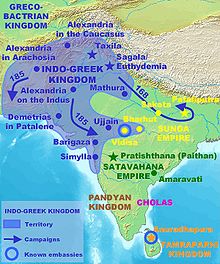


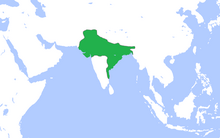




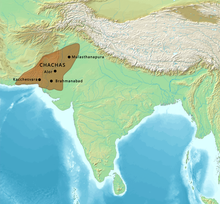
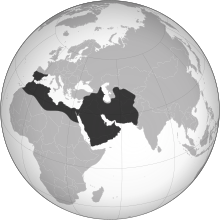






















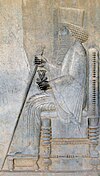
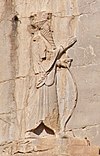




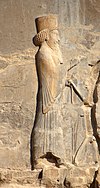
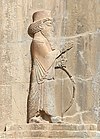
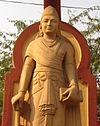
























![Indian coinage (Pagoda) of Mu'izz al-Din Muhammad. Obverse: Lakshmi seated facing. Reverse: śri maha/[mi]ra mahama/da sama in Devanagari.](http://upload.wikimedia.org/wikipedia/commons/thumb/9/92/Mu%27izz_al-Din_Muhammad_bin_Sam._AH_599-602_AD_1171-1206._Pagoda_coin_with._Lakshmi_seated_facing.jpg/100px-Mu%27izz_al-Din_Muhammad_bin_Sam._AH_599-602_AD_1171-1206._Pagoda_coin_with._Lakshmi_seated_facing.jpg)









































